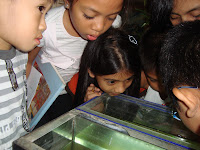-----------------------------------
To me, Manang Madre's aquarium was a laboratory, the curious kid that I was. It introduced me - and many kids - into a realm I would be devoting a lifetime as biologist. It left an indelible mark of nature's self-contained system - the dynamic balance that keeps order and harmony in nature which scientists call homeostasis.
---------------------------------------
Dr Abe V Rotor
Living with Nature - School on Blog
Paaralang Bayan sa Himpapawid (People's School-on-Air)
with Ms Melly C Tenorio
with Ms Melly C Tenorio
738 DZRB AM Band, 8 to 9 Evening Class, Monday to Friday
There was no electricity then, and therefore there were no motorized air pumps and filters, aquarium lights, oxygen generators, and the like, which we use in aquariums today. Yet the aquarium in those days was beautiful in its own natural way, and it was simple and easy to maintain.
Glass aquarium at home
When I was a kid I used to visit my cousin who later joined a religious order (Sister Francisca Rotor, SPC) just to watch and ponder on her glass aquarium sitting on a window facing the northeast. The sun shone through the glass, its rays splitting into the prism of the rainbow spreading on the aquatic plants, and the playful goldfish. Bubbles hanged on the glistening Elodea and Hydrilla plants, then rose slowly to the top faintly hissing and popping. I now understand that these bubbles are pure oxygen, the by-products of photosynthesis.
At the bottom and side of the aquarium were small snails which did the job of the janitor fish as gleaners and cleaners. Snails scrape off algal crust and being saprophytes too, convert organic matter into detritus which is equivalent to compost - in turn provides nutrition to the aquatic plants. Carbon dioxide emitted by the fish and snail is used by the plants for photosynthesis, and in the process produce sugar, and oxygen as by-product. Sugar is subsequently converted into other organic compounds which are necessary for the plants to grow and gain biomass. Being herbivores fish and snail depend upon the plant.
The secret of a stable aquarium is balanced gas exchange and organic-inorganic cycle. Once this is attained we can say the aquarium is a "balanced ecosystem," a microcosm of a pond or lake.
To me, Manang Madre's aquarium was a laboratory, the curious kid that I was. It introduced me into a realm I would be devoting much of my time as biologist. It left an indelible mark of nature's self-contained system - the dynamic balance that keeps order and harmony in nature which scientists call homeostasis.
Manang Madre aquarium soon led me to search for great minds and their works, among them, Aristotle's Natural History, Darwin's Theory of Evolution, Oparin's Beginning of Life, Cousteau's Oceanography, EO Wilson's Sociobiology, Leeuwenhoek's Microscopy, and Henry David Thoreau's Treatise of Nature and Man.
On the other hand I taught my students to build aquariums without any electrical gadget, telling them, "In any experiment, understand and apply the laws of nature."
Why don't you put up a project in your home or school, and replicate Manang Madre's natural aquarium? It is peeping through the keyhole of magnificent creation. ~
Discovering a wonderful world under the sea- A natural aquarium is a miniature pond, lake, or sea.
- The basic principle is conversion of the sun's energy into food and oxygen by algae and plants (photosynthesizers).
- Food and oxygen are important to fish and other animals.
- In return, the animals give off "waste" as nutrients and carbon dioxide important to plants.
- A natural aquarium therefore is a simple ecosystem, balanced environment.
- Like any ecosystem, its balance depends on healthy interrelationship of the living and non-living world.
- The organisms are classified into producers (plants, algae), and consumers (fish, snails), and decomposers (bacteria)
- Balance is dynamic, it changes, but nature guides it to attain stability or homeostasis.
- Energy flow goes through the food chain, food web, food pyramid.
- Humans are part of this system, and has assumed dominance over other organisms.
- Nature takes care of itself even without man. Thus, forests, coral reefs, and the like, are best maintained without man's intervention.
- On the other hand it is man that may destroy this natural balance through pollution, over fishing chemical farming, deforestation - and global warming, which is a consequence of man's increasing number and affluence. ~
Natural Aquarium as a Miniature Ecosystem
I loved watching the guppies in an old fashioned aquarium
sans any gadget for lighting, filter, and fancy screen;
the sun, the provider of food and oxygen through the algae
clinging on rock, and snails living off the glass clean.
I was a kid then eager to discover the mysteries of nature;
a little of Darwin, Linnaeus, and Arthur Doyle I sought,
a little of Darwin, Linnaeus, and Arthur Doyle I sought,
of Fleming's serendipity and Leeuwenhoek's microscopy,
seeing their images in an aquarium my cousin taught.
It was schooling, experimenting, and above all, dreaming,
it took me to a little Smithsonian, to a niche in biology,
archive of living history, the microcosm of the living world,











No comments:
Post a Comment